Follow the steps below to load the envelopes.
Before you begin
 With a properly specified setting in the printer driver, the address is automatically rotated and printed based on the envelope's direction.
With a properly specified setting in the printer driver, the address is automatically rotated and printed based on the envelope's direction.
 Do not use the envelopes below. They could jam in the printer or cause the printer to malfunction.
Do not use the envelopes below. They could jam in the printer or cause the printer to malfunction.
-
Envelopes with an embossed or treated surface.
-
Envelopes with a double flap.
-
Envelopes whose gummed flaps are already moistened and adhesive.
Prepare the envelopes
-
Press down on all four corners and edges of the envelopes to flatten them.

-
If the envelopes are curled, hold the opposite corners and gently twist them in the opposite direction.

-
If the corner of the envelope flap is folded, flatten it.
-
Use a pen to press the leading edge to be inserted in the printer in order to flatten and sharpen the crease.

 The figures above show a side view of the leading edge of the envelope.
The figures above show a side view of the leading edge of the envelope.
 The envelopes may jam in the printer if they are not flat or the edges are not aligned. Make sure that no curl or puff exceeds 0.12 in. (3 mm).
The envelopes may jam in the printer if they are not flat or the edges are not aligned. Make sure that no curl or puff exceeds 0.12 in. (3 mm).
Prepare the printer and insert the envelopes
-
Open the rear tray cover (A). The paper output slot cover will open automatically.
-
Pull out the paper support (B) until the arrow right arrow mark  is aligned with the left arrow mark
is aligned with the left arrow mark  .
.
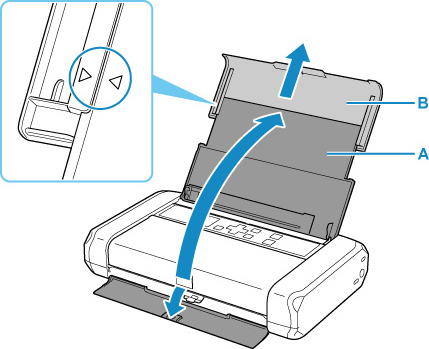
-
Slide the paper guide (C) to the left, and load the envelopes against the far right side (D) of the rear tray with the side of the paper to be printed on facing you.
 Up to 10 envelopes can be loaded at once.
Up to 10 envelopes can be loaded at once.
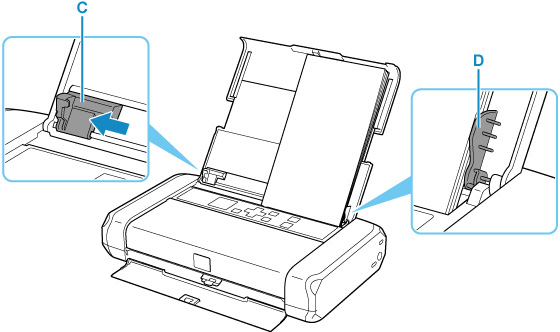
- Fold the flap of the envelope and load it in portrait orientation with the address side face up.

-
Slide the paper guide to align it with the envelopes.
 Do not slide the paper guide too hard against the envelopes. The envelopes may not be fed properly.
Do not slide the paper guide too hard against the envelopes. The envelopes may not be fed properly.
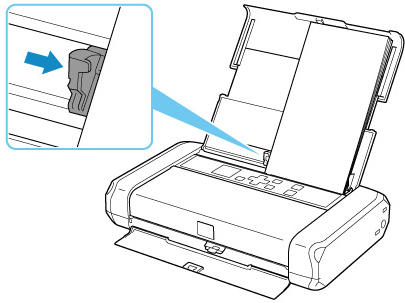
-
Keep the envelope stack height below the tab (E) of the paper guide.
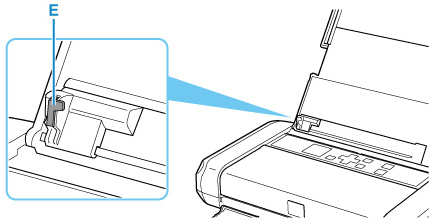
-
Set the paper thickness lever (F) to the left.
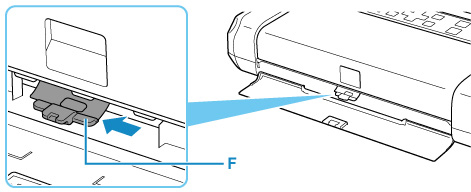
-
Reset the paper thickness lever to the right when your finished with the prints.
-
After you close the feed slot cover, the paper setting confirmation screen for the rear tray appears on the LCD.
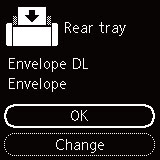
-
If the page size and media type shown on LCD match the size and type of envelopes loaded in the rear tray, select OK.
-
If not, select Change to change the settings in accordance with the size and type of the loaded envelopes.
 A function is built into the printer that detects if the paper settings for the rear tray matches the print settings. An error message will pop up if the settings are incorrect and will stop the print job. Make sure the settings always match before you begin.
A function is built into the printer that detects if the paper settings for the rear tray matches the print settings. An error message will pop up if the settings are incorrect and will stop the print job. Make sure the settings always match before you begin.
If your product issue was not resolved after following the steps above, or if you require additional help, please create or log in to your Canon Account to see your technical support options.
Or if you still need help, visit our Canon Community by clicking the button below to get answers:

____________________________________________________________________________________________